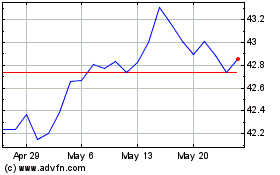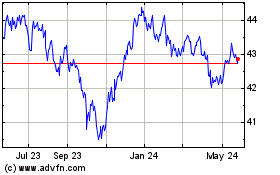After taking it easy in the second half of 2011, iShares appears
to be fighting back a number of surging issuers by launching a
variety of new products to start the new year. In fact, the company
has debuted over 25 funds in the time period, pushing its total
offering well above the 250 fund mark. However, all of these funds
look to be in the equity world, rounding out the company’s offering
list in segments including commodity producers, European equities,
and emerging market stocks. However, in the latest release, this
looks to be changing as the company has revealed seven new,
targeted bond ETFs for investors (see Top Three High Yield Junk
Bond ETFs).
The new products segment the bond asset class in relatively
unique ways, allowing investors to further target any corner of the
bond world that they so choose. Additionally, it also helps the
company to better compete in the fixed income world as a number of
companies—specifically PIMCO, PowerShares, and Van Eck-- have seen
decent inflows in months past in their fixed income lineups.
Hopefully from iShares’ perspective, the new launches will allow
the San Francisco-based firm to continue to dominate the bond ETF
world as it currently does in the equity space.
With that being said, the new funds should also be welcomed news
to investors as well, offering better segmentation in the fixed
income corner of the exchange-traded world. For investors who are
looking to further segment their bond holdings, or are curious as
to how the new products could fit into a portfolio, we have
highlighted some of the key details from the iShares launch
below:
Utilities Sector Bond Fund (AMPS)
This fund tracks the Barclays Capital U.S. Utility Bond index,
giving investors exposure to bonds from about 54 companies that are
in the utilities space while charging 30 basis points a year in
fees. With this focus, the level of risk may be lower than in
comparable funds in other sectors, suggesting that it could be a
good option for those seeking minimal volatility (read Utility
ETFs: Slumping Sector In Rebounding Market).
In terms of industry focus, electric utilities make up close to
70% while natural gas utilities make up the remainder of the
product. Meanwhile, the effective duration comes in at around 8.6
years for the underlying index as more than 57% of the holdings
mature in less than 10 years. This gives the index an average yield
to maturity of about 3.4%, a decent level but one that isn’t
exactly an ultra-high payout either.
Industrials Sector Bond Fund (ENGN)
For investors searching for bonds of companies outside the
financial and utilities sectors, a closer look at ENGN could be
warranted. The product tracks an index of about 71 bonds, charging
investors a low 30 basis points a year in fees. Sector exposure is
tilted towards consumer staples (25%), communication (19.8%), and
energy (12.5%) while the effective duration is just 7.3 years.
Given this focus on lower duration securities, as well as more
highly rated bonds, the product has a lower yield of 3.1%. Still,
this is far higher than many Treasury bond funds in the space and
the focus on industrial bonds could be ideal for some investors
seeking more targeted exposure.
Financials Sector Bond Fund (MONY)
If investors are looking to gain access to the financial sector
but are worried about the significant volatility in the equity
space, MONY could be a less volatile way to go instead. The
new fund targets about 65 bonds in total, charging investors 30
basis points a year in fees. Banking firms dominate the underlying
index, comprising about 63% of the total, although insurance firms
also make up a decent chunk at 19.8% (see Capital Markets ETF For
2012?).
Investors should also note that the fund is tilted towards
securities in the A+ to A- range on the S&P scale, meaning that
the fund is relatively safe but isn’t heavily exposed to top notch
financials. Despite this and the index’s relatively low duration of
5.4 years, the yield to maturity is a respectable 3.8% for the
benchmark of MONY.
Barclays U.S. Treasury Bond Fund (GOVT)
For a low cost way to play the U.S. Treasury bond market, GOVT
could be a new way to go. The fund holds bonds from across the
curve, charging investors just 15 basis points a year in fees for
its services. While the product is definitely tilted towards
short-term bonds—those maturing in one to five years make up 56% of
the index while five to ten years makes up another 27%-- 25+ year
bonds also make up about 10.7% as well.
Unfortunately, the fund may not be a great destination for
yield, although it will probably be a good spot for safety. The
underlying index has an average yield to maturity below 1% while
the weighted average coupon is just 2.6% (read Three Bond ETFs For
A Fixed Income Bear Market).
Barclays GNMA Bond Fund (GNMA)
To target mortgage-backed pass-through securities issued by the
Government National Mortgage Association, investors could consider
GNMA. The product holds just 13 securities in total and charges
investors 32 basis points a year in fees, potentially giving
investors quality access to the MBS segment. Interestingly,
investors should note that many of the bonds do not mature for
quite some time but the effective duration on the index is still
quite low, coming in at just under 3.2 years. Still, the yield to
maturity of the benchmark is 2.6%, a decent level considering the
relatively short-term and low risk focus of the fund.
Barclays CMBS Bond Fund (CMBS)
If investors prefer the commercial side of the real estate
market to residential, a closer look at CMBS could be warranted.
The product tracks the Barclays Capital U.S. CMBS Index, following
a benchmark of Erisa-eligible commercial mortgage-backed securities
market. In total, the fund holds 25 securities while charging 25
basis points a year in fees. Investors should note that the
holdings breakdown is decidedly short term as the vast majority of
the underlying index matures in less than five years while all of
the components mature in less than 10. However, given the slightly
higher risk of this corner in the market, despite the AAA rating of
many underlying securities, the benchmark still has a decent yield
at 3.2%.
Aaa-A Rated Corporate Bond Fund (QLTA)
For investors who only want the cream of the crop in the
corporate bond market, QLTA makes for an interesting choice. The
product only focuses on highly rated securities, ensuring that
return of capital will be achieved by virtually all the bonds in
question. Additionally, the underlying index is tilted towards
short-term securities, reducing interest rate risk as well,
suggesting that the fund could be a good pick for those looking for
slightly higher risks than Treasury bonds but not too much higher
than those ultra-safe securities (see The Best Bond ETF You Have
Never Heard Of).
However, investors must pay for this added safety with lower
yields, as the underlying index in the fund pays out just over 2.9%
in yield to maturity terms. While this level may be higher
than government bond funds on this list, it is also far lower than
many of the industry focused products which are more liberal in the
credit quality profile of their holdings.
Want the latest recommendations from Zacks Investment Research?
Today, you can download 7 Best Stocks for the Next 30
Days. Click to get this free report >>
To read this article on Zacks.com click here.
Zacks Investment Research
Want the latest recommendations from Zacks Investment Research?
Today, you can download 7 Best Stocks for the Next 30 Days. Click
to get this free report
iShares GNMA (NASDAQ:GNMA)
Historical Stock Chart
From Apr 2024 to May 2024

iShares GNMA (NASDAQ:GNMA)
Historical Stock Chart
From May 2023 to May 2024
